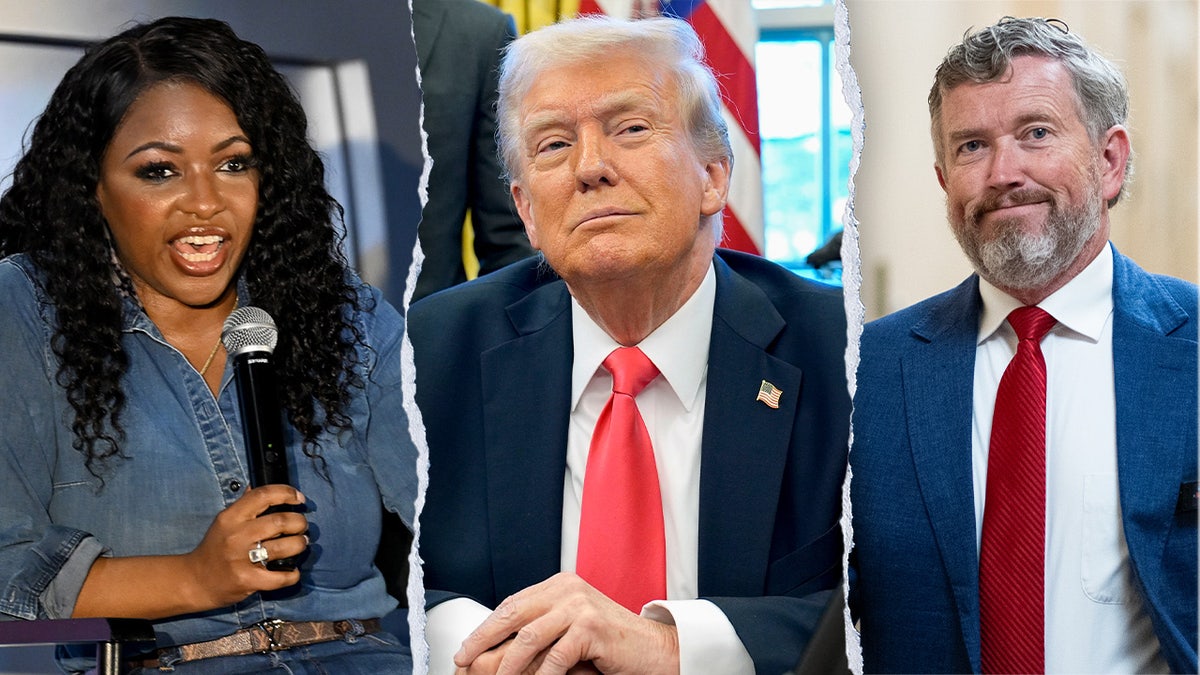A Fictional “On-Air Reversal” Between Trump and Jasmine Crockett Goes Viral, Reflecting How Political Fan Fiction Now Spreads Like News
A dramatic headline spread rapidly across social media this week —
“Trump INSULTS Jasmine Crockett LIVE — Then She TURNS His Insult Into Explosive Applause In a Stunning On-Air Reversal.”

Despite the breathless phrasing and the implication of a live, nationally broadcast confrontation, no such exchange occurred.
Yet the fictional clip, stitched together through edited footage, AI-generated narration, and reaction audio borrowed from unrelated programs, circulated widely across TikTok, Instagram Reels, YouTube Shorts and X. It quickly became one of the week’s most shared political videos, illustrating the growing force of political fan fiction in the digital sphere.
A Fabricated Moment Constructed From Real Personalities
The viral video typically shows a montage of older footage of Representative Jasmine Crockett, combined with archival clips of former President Donald J. Trump. Through careful editing and selective audio overlays, creators framed an entirely fictional moment in which Trump delivers a sharp insult and Crockett responds with a decisive, applause-generating comeback.
The structure mirrors the rhythm of a late-night political monologue: tension, confrontation, reversal, eruption. But the moment never took place on any legitimate broadcast.
“This is a mash-up engineered to feel like a live takedown,” said Dr. Helena Ortiz, a professor of communication studies at the University of Texas. “It blends recognizable faces with invented dialogue in a way that is emotionally coherent, even if factually impossible.”
Why the Fiction Felt Plausible

Several factors helped the fictional exchange resonate with viewers:
1. Crockett’s developing public profile
Rep. Crockett has gained national attention through assertive, sharply articulated exchanges during congressional hearings. Her public persona already aligns with the narrative of a quick, incisive responder. Viewers were primed to accept the fictional moment as “something she would say,” even though she never said it.
2. Trump’s long history of confrontational media moments
Trump’s rhetorical style — often unscripted, improvisational, and combative — has created a cultural expectation that he might insult a political opponent on camera. The fabricated clip draws directly from popular perceptions rather than real events.
3. Familiar political storytelling tropes
A powerful figure issues a jab; an underestimated opponent delivers a viral rebuttal. This narrative structure has become a hallmark of political entertainment content, especially online.
“These are archetypes, not facts,” Dr. Ortiz said. “The clip succeeds because it taps into familiar emotional roles audiences already understand.”
Shaped Like News, Delivered Like Entertainment
The clip’s presentation closely mirrors the aesthetics of breaking news.
Creators employed flashing red banners, ⚡ emojis, slow-motion cuts, dramatic zooms, and AI-generated crowd audio to simulate a live studio meltdown. Some versions added fabricated chatter from control-room producers or phony gasps from a studio audience.
“These visual cues are not accidental,” said Dr. Marcus Dwyer, a media historian at Columbia University. “They are designed to trigger the viewer’s conditioned response to crisis and revelation.”
The effect is not malicious deception so much as emotional engineering: news elements are used to package a fictional confrontation as entertainment.
The Algorithmic Fuel Behind Viral Political Fiction
The clip went viral not because audiences believed it was real, but because the platforms rewarded its emotional energy. The headline’s language — INSULTS, EXPLOSIVE APPLAUSE, REVERSAL — is structured to maximize engagement.
“Algorithms favor conflict-based storytelling,” Dr. Dwyer explained.
“A fictional takedown spreads for the same reason a sensational sports highlight spreads: it delivers adrenaline.”
On TikTok, duets and reaction videos amplified the clip. On Instagram, meme pages reframed it with additional commentary. On X, political accounts shared it as either satire, wish fulfillment, or evidence of media bias — all reactions that further boosted visibility.
A Symbolic Battle, Not a Real One
Although the moment is invented, the narrative functioned as a proxy battleground for real political debates. Commenters praised Crockett’s supposed rhetorical agility, criticized Trump’s imagined behavior, or used the clip to discuss representation, generational shifts in Congress, or declining trust in media.
“This is political discourse happening through fiction,” Dr. Ortiz said.
“People debate the implications of a moment that never occurred because it feels emotionally relevant.”
The clip’s popularity underscores how online communities increasingly use narrative — not factual events — to process political identity and conflict.
Conclusion
There was no live insult, no sharp comeback, and no eruption of applause.
The viral clip is pure fabrication, constructed from edited footage and presented in the familiar cadence of political entertainment.
But its popularity is revealing: in the modern media landscape, political imagination often spreads faster than political reality. Fictional confrontations, engineered for emotional punch, have become central to how many Americans experience politics online.
As algorithms continue to amplify dramatic narratives, the challenge is no longer simply verifying what is real — but understanding why so many prefer stories that aren’t.





